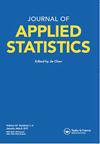Forecasting of the true satellite carbon monoxide data with ensemble empirical mode decomposition, singular value decomposition and moving average
IF 1.2
4区 数学
Q2 STATISTICS & PROBABILITY
引用次数: 0
Abstract
AbstractThe forecasting of carbon monoxide in the atmosphere is essential as it causes the pollution of the atmosphere and hence severe health problems for humans. This study proposes a time-series prognosis EEMD-SVD-MA technique which incorporates Ensemble Empirical Mode Decomposition, Singular Value Decomposition and Moving Average, to predict the prospects of carbon monoxide data taken from the Indian region. The collected data are non-linear. The technique can be applied for non-stationary and non-linear data. In this approach, there are three levels: EEMD level, SVD level and MA level. The first level deploys EEMD to fragment data series into a limited number of Intrinsic Mode Function (IMF) components along with a residue. To denoise each IMF component, SVD is deployed in the second level. In the third level, each denoised IMF component is predicted by MA. The future values of the original data are obtained by adding all the predicted series of the components. In this study, we proposed two variants of the model: EEMD-SVD-MA(3) and EEMD-SVD-MA(4) and compared the results with other forecasting techniques, namely LSTM (Long Short Term Memory network), EMD-LSTM, EMD-MA, EEMD-MA and CEEMDAN-MA. The results show that the proposed EEMD-SVD-MA model is more efficient than other models.Keywords: Intrinsic mode functionempirical mode decompositionensemble empirical mode decompositionsingular value decompositionmoving averagelong short term memory networkMathematics Subject Classifications: 37M1068T0715A18 AcknowledgmentsThe author's deep appreciation goes out to NASA's teams for AIRS/AMSU, MODIS and MOPPIT data for tropospheric CO.Disclosure statementNo potential conflict of interest was reported by the author(s).用集合经验模态分解、奇异值分解和移动平均预测真卫星一氧化碳数据
摘要大气中一氧化碳的预测是必不可少的,因为它会造成大气污染,从而给人类带来严重的健康问题。本文提出了一种结合集合经验模态分解、奇异值分解和移动平均的时间序列预测EEMD-SVD-MA技术,用于预测印度地区一氧化碳数据的前景。收集的数据是非线性的。该技术可以应用于非平稳和非线性数据。在这种方法中,有三个级别:EEMD级别,SVD级别和MA级别。第一级部署EEMD,将数据序列分解为有限数量的内模态函数(IMF)组件和剩余部分。为了对每个IMF分量进行降噪,在第二层部署了奇异值分解。在第三个层次,每个去噪的IMF分量用MA进行预测。将各分量的预测序列相加,得到原始数据的未来值。在本研究中,我们提出了两个模型的变体:EEMD-SVD-MA(3)和EEMD-SVD-MA(4),并将结果与LSTM(长短期记忆网络)、EMD-LSTM、EMD-MA、EEMD-MA和CEEMDAN-MA进行了比较。结果表明,本文提出的EEMD-SVD-MA模型比其他模型更有效。关键词:内禀模态函数经验模态分解集成经验模态分解奇异值分解移动平均长期短期记忆网络数学学科分类:37M1068T0715A18致谢作者对NASA团队提供的AIRS/AMSU、MODIS和MOPPIT对流层大气大气数据表示深深的感谢披露声明作者未报告潜在的利益冲突。
本文章由计算机程序翻译,如有差异,请以英文原文为准。
求助全文
约1分钟内获得全文
求助全文
来源期刊

Journal of Applied Statistics
数学-统计学与概率论
CiteScore
3.40
自引率
0.00%
发文量
126
审稿时长
6 months
期刊介绍:
Journal of Applied Statistics provides a forum for communication between both applied statisticians and users of applied statistical techniques across a wide range of disciplines. These areas include business, computing, economics, ecology, education, management, medicine, operational research and sociology, but papers from other areas are also considered. The editorial policy is to publish rigorous but clear and accessible papers on applied techniques. Purely theoretical papers are avoided but those on theoretical developments which clearly demonstrate significant applied potential are welcomed. Each paper is submitted to at least two independent referees.
 求助内容:
求助内容: 应助结果提醒方式:
应助结果提醒方式:


